As gun violence and killings rise, Kansas City police launch citywide crime reduction plan
As violence continues to claim a mounting number of lives, including seven people in a span of three days over the Memorial Day weekend, the Kansas City Police Department’s chief is touting a citywide plan to reduce crime.
The Violent Crime Reduction Initiative first unveiled at a news conference in mid-May and doubled down on by officials Wednesday after the latest spike in violence involves what’s described as an aggressive collaboration between police and a host of other groups, who have ventured into some of the poorest neighborhoods to knock on doors, offering social services, and promising enhanced city services to further spread the gospel of crime prevention.
Several community activists and those working with KCPD say the new strategy encourages more collaboration between police and local organizations. But they also say it’s not all that new of a concept. Others are even less optimistic, pointing to a fractured relationship between police and the community, and a focus on criminals instead of the underlying causes of violence.
Chief Stacey Graves said the crime reduction plan is not her plan, but a citywide initiative that has the police department working alongside county prosecutors, crime-fighting groups, federal authorities and various city agencies.
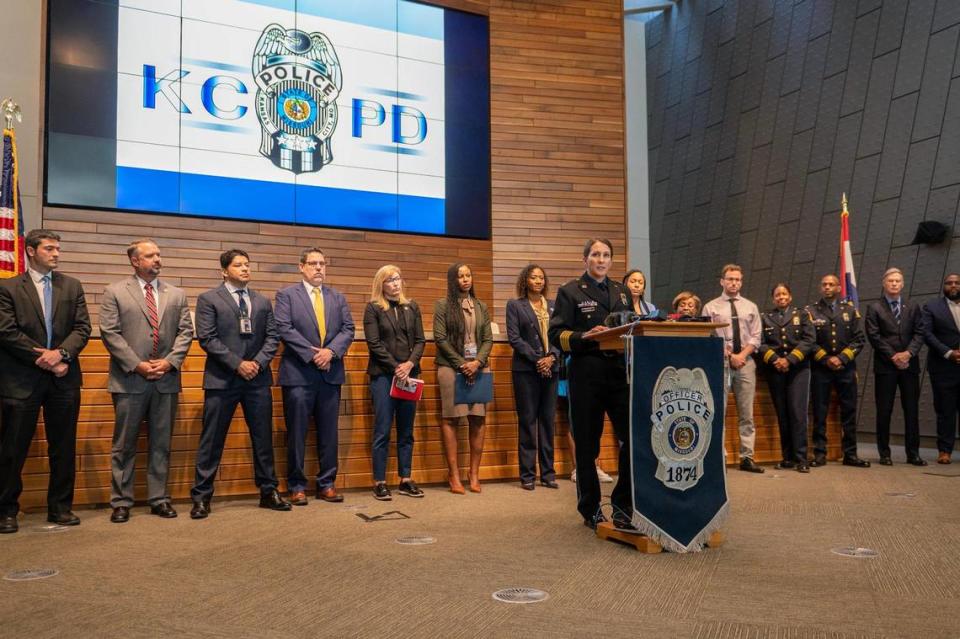
“We have been out in our neighborhoods,” she said. “One of our goals is to show the community we see criminal activity happening in their neighborhoods, and we are responding to help. Also that we see other concerns affecting the quality of life in their respective neighborhoods.”
The initiative faces a daunting challenge: As of the end of May, there have been 77 homicides reported this year in Kansas City, according to data collected by The Star, which includes fatal police shootings. At this time in 2022 — which became the second deadliest year on record with 171 homicides — the city had recorded 67 homicides.
Since Graves hosted the press conference May 17 announcing the new crime reduction plan, there have been 16 killings reported in Kansas City, including a mass shooting at a nightclub where three people died.
As of May 28, KCPD reported 197 non-fatal shooting victims. For the same period in 2022, there were 184 non-fatal shootings. There were 39 non-fatal shootings in May, according to police.
On Wednesday, Graves said the Memorial Day weekend was particularly violent. In a span of 72 hours, KCPD officers responded to seven homicide scenes.
“Seven families our city have been changed forever. This is a call for action. Our department will continue to show up, but we need the community,” Graves said.
Mayor Quinton Lucas said the new plan addresses prevention, intervention, enforcement and police reform.
“It is bringing in neighborhood groups in ways that we never have before. We recognize there’s a very real challenge and the status quo just won’t work,” said Lucas.
“So we’re gonna keep trying, and I know people sometimes get frustrated and say, ‘It always feels like there’s a new plan.’ Of course, as long as there’re murderers on our streets we will always have new plans and initiatives to try to get things resolved,” Lucas recently told The Star.
“And to me, it’s urgent. It’s essential, and frankly, we need to try to make sure that we do all that we can to support it,” he said.
Yet some community activists say they are skeptical the crime reduction plan will have an immediate and lasting impact. They say it’s just the latest in the series of crime-fighting and violence prevention campaigns launched over the past decade with great fanfare and promise, but eventually lost momentum and were abandoned.
“I look at it as lip service for now,” said Steve Young, who leads the Kansas City Law Enforcement Accountability Project or KC LEAP. “We want some action. We have been through a long history of bad (police) chiefs here in Kansas City.”
“I believe that Chief Graves has a very steep hill to climb right now and it’s going to take more to convince me that she’s actually here to do the work.”
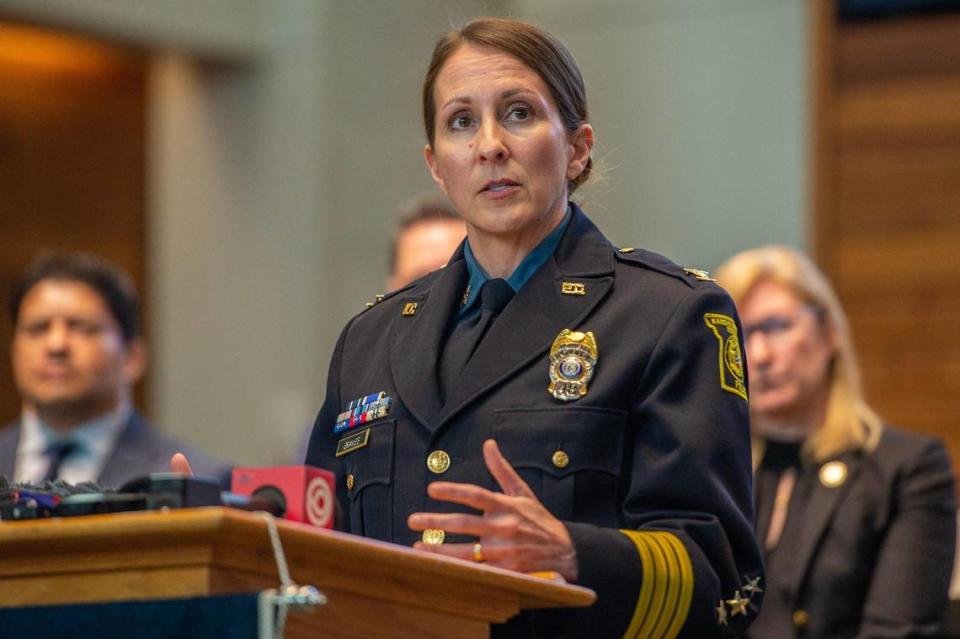
Pulling from the past
Kansas City is one of countless communities across the country where gun violence is treated as a crime problem that can be solved by law enforcement. But after spending millions of dollars every year on police budgets and prisons, the problem is worse than ever.
Graves said the crime reduction plan incorporates some elements of past crime-fighting efforts such as “focused deterrence,” which targets violent people and their associates. Authorities offer them a choice to change their behavior or go to jail.
Earlier this month, KCPD and federal authorities conducted warrant sweeps and arrested those wanted on various weapons and criminal charges. It was the first time this year that authorities went after those accused of possessing illegal firearms, police said.
As part of the violent crime reduction initiative, KCPD and other law enforcement agencies arrested 88 people wanted on federal, state and municipal warrants.
However, over the last decade or so, KCPD has conducted other such warrant sweeps.
KCPD will also follow up on active warrants and make contact with residents in areas where violent crime has occurred.
“An emphasis will be on community outreach and enforcement of violent offenders in an effort to deter and decrease violent criminal activity, making Kansas City safer and choosing where to focus these efforts,” Graves said.
KCPD will soon announce the reformation of an illegal firearms squad. Graves said details of the squad will be released in the next few weeks. But it also isn’t the first time that KCPD has rolled out such an effort to seize illegal weapons, including handguns.
Another prevention program called Partners for Peace was launched in 2022, deemed by some as part of a new iteration of the Kansas City No Violence Alliance, the last program many local leaders said actually worked to reduce violence before being cut.
The new program operates as a collaboration between the city, the Jackson County Prosecutor’s Office and KCPD, and brings together local agencies and nonprofit groups to offer help with grief and trauma counseling, job training and rent and utility assistance. The group works with KCPD homicide detectives to help prevent retaliation.
“But we still have to play the long game of prevention, working with neighborhood associations to make sure that they have the capacity and resources they need to create healthy environments for kids, for residents, for elders and things of that nature,” said Melesa Johnson, who serves as the mayor’s director of public safety.
Johnson said the group receives some funding from the Jackson County anti-drug tax, but will apply for a grant that will available through the $30 million the Kansas City Council recently set aside for crime prevention efforts.
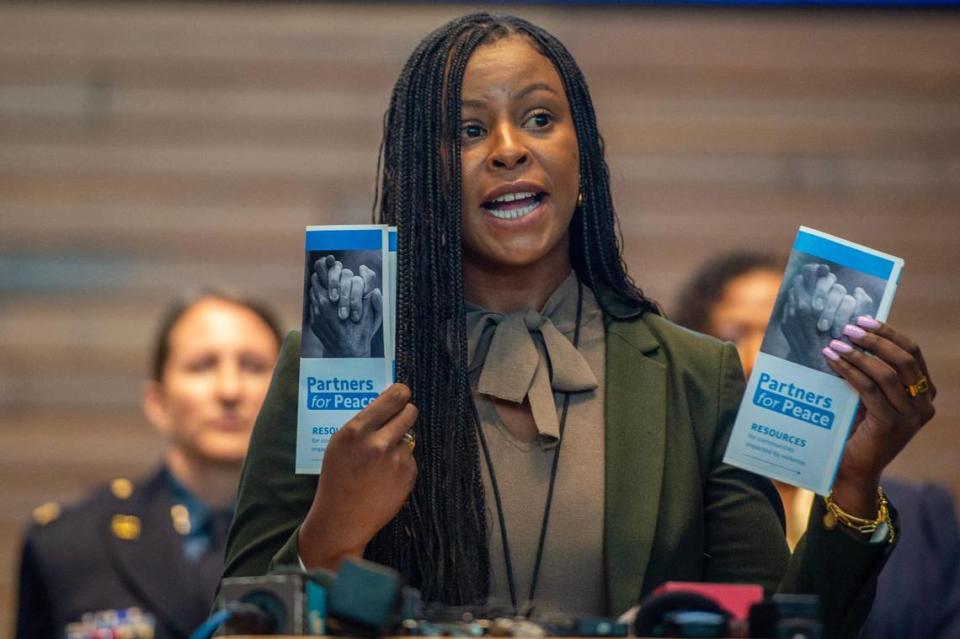
Gwen Grant, president of the Urban League of Greater Kansas City, said a citywide crime reduction strategy is needed.
“Our inner-city neighborhoods are in distress,” Grant said. “Linking people who are most proximate to violent crime to social services, including access to livable wage jobs, quality, affordable housing, healthcare, and more, has proven to be an effective violence reduction and crime prevention strategy.”
She said the work being done by Partners for Peace, which includes the Urban League as a member, is a step in the right direction.
“I would, however, offer a word of caution. Escalating traffic stops, and business and residence checks could be problematic. KCPD already has a negative reputation for racial profiling; research has shown that flooding communities with increased police presence alone does not reduce violent crime,” Grant said.
“In fact, if handled poorly, it could widen the existing chasm between police and the community, thereby making it more difficult to get the cooperation needed to solve violent crimes.”
A collective approach is needed in order to address the rampant gun violence, said Jackson County Prosecutor Jean Peters Baker.
“One of the key things I’ve learned is in this job is when you approach somebody no matter who they are, where they are from and what their life experiences are, if you approach them with a degree of humility and understanding and a desire to want to know them, the door generally opens to you the dialogue generally openness,” Baker said recently.
Collaborations to cut crime
The citywide crime reduction plan being promoted by Graves will reportedly take advantage of KCPD’s ongoing partnerships with various community based nonprofit organizations such as the AdHoc Group Against Crime, Mothers In Charge and KC Common Good.
But it’s not yet clear what the roadmap looks like to ensure these agencies effectively work together with KCPD to provide consistent, cohesive efforts to combat crime, or how it differs from what they’ve already been doing.
Branden Mims, chief operations officer for AdHoc, said in previous years, for example, there was inconsistency in how authorities responded to non-fatal shooting victims. Recently, that task was handled by the Jackson County Prosecutor’s Office who sent representatives from AdHoc and their office to meet with victims and witnesses.
The prosecutor’s office used money from their annual budget to help victims repair damage caused by gunfire. They also referred victims to counseling, purchased food and provided other assistance.
Mims said they are now able to help victims with those repairs, but also have money available to immediately relocate victims and witnesses.
“We’re hoping that through community involvement, through reaching out to non-fatal shooting victims to offer services and getting some cooperation from witnesses and victims who feel that they can remain safe and cooperate will make the difference,” he said.
Other organizations which have worked with KCPD over the years said there is nothing new under this plan.
Members of KC Mothers in Charge, an anti-violence nonprofit group will continue to respond to homicide scenes and offer support and counseling to the relatives of homicide victims.
As they did in the past, Mothers in Charge often visits the neighborhoods where homicides and non-fatal shootings have occurred to pass out brochures about trauma, said Rosilyn Temple, who helped open the Mothers in Charge office in Kansas City a decade ago in 2013.
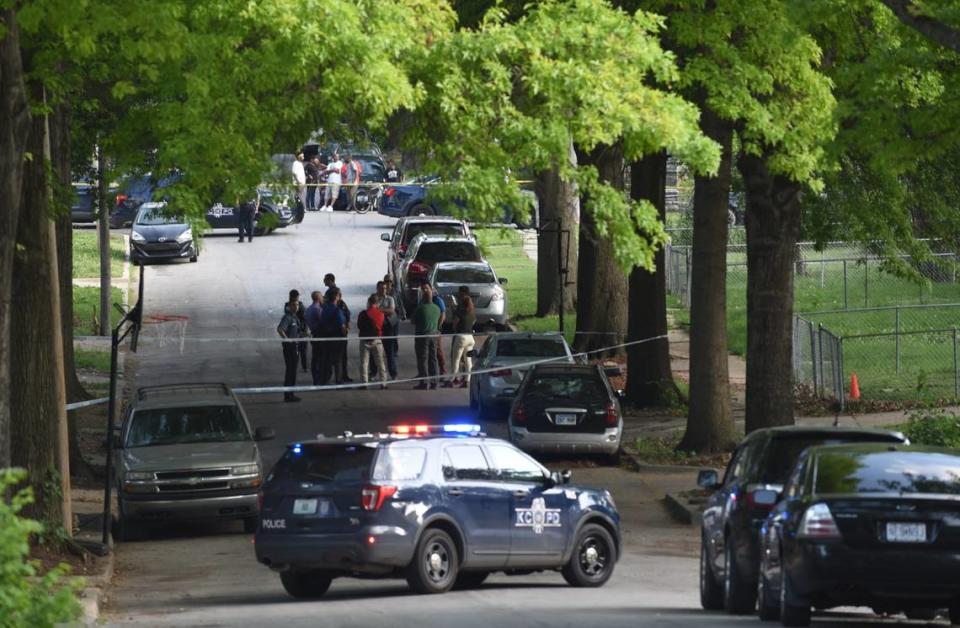
Those collaborative relationships along with partnering with other law enforcement and outreach efforts by community groups are key elements of the new initiative.
Graves has also pledged to hold quarterly town hall meetings and listening sessions throughout Kansas City. The various patrol divisions will schedule regular meetings with residents and provide them neighborhood crime data.
“We need to build bridges, improve and strengthen relationships and forge new partnerships to build trust and we need to start that by listening,” Graves said during a recent town hall meeting held in south Kansas City.
“It’s not going to be just the police that’s going to solve the issues of violent crime. Who are we to come into a neighborhood and tell someone what their problems are and how to solve them?”
Creating measurable benchmarks will be critical to the success of the citywide crime reduction plan, said Marijana Kotlaja, an assistant professor of criminal justice at the University of Missouri-Kansas City.
“Sustainability is going to be key,” Kotlaja said. “We know from other cities implementing violence reduction initiatives that community readiness, collaboration with community coalitions, the intervention itself and financial sustainability are very important to overall success.”
“This approach appears to be much more multifaceted than those that I am aware of having been implemented in the past in Kansas City,” she said.
The community engagement unit was formed in December and will be among those officers who visit homes where gunfire has been reported. The team includes about 65 civilian and sworn officers who are social workers, community interaction officers from each of the six patrol divisions and department chaplains.
The department is already working with neighborhood leaders to help identify potential trouble spots and prevent minor neighborhood squabbles that can explode into deadly gun violence.
“I constantly tell people that a police officer is nothing more than a referee,” said Pat Clarke, a longtime member of the Oak Park Neighborhood Association.
Clarke had previously worked as a community outreach specialist for former KCPD Police Chief Darryl Forté. In order to further reduce crime, residents have to take responsibility and be accountable for what goes on inside their homes, he said.
“When you allow your kids to walk around your house with a gun and they tell you they’re going to do something to somebody, and you don’t call nobody until after it happens, then it’s not on the city, it’s on us,” Clarke said.
Repeat offenders and ‘generations of trauma’
Another priority of the new citywide crime reduction plan is to go after repeat violent offenders.
In recent weeks, Baker said she and others in law enforcement have knocked on the doors of the city’s prolific criminals, those who are likely to settle scores with violence or gunfire.
That effort was similar to the Kansas City No Violence Alliance or KC NoVa launched in 2014, which was considered an innovative crime-fighting approach. It was a collaboration between city, state and federal agencies and used prevention and discipline, which had been used to curb violence in other cities. Homicides in Kansas City dropped to an historic low.
But by 2019, then-Police Chief Rick Smith abandoned the program, pulling officers and other resources away from the program, and homicides in Kansas City climbed to historic levels.
Graves said the new citywide crime initiative will not fully restore KC NoVA, but will use elements of the program that made it successful.
KC Common Good launched their program, KC 360, last year as another approach to combat violent crime in neighborhoods including Oak Park and the Santa Fe neighborhood.
The goal is to build a community-based effort to reduce gun violence, build stronger community relations and implement policing reforms. It’s modeled after a similar program that has seen success in Omaha, Neb.
Additional officers have also been added to patrol as a way to improve response time to 911 calls in Kansas City.
Lucas recently described the delays in answering and responding to 911 calls as “terrifying and unacceptable.” Last week, Lucas’s sister called 911 for their mother and she waited on hold for five minutes to speak to a dispatcher.
Despite budget increases aimed at boosting the police force, the problem remains.
“Every year the City Council appropriates funding for far greater than the number of police positions that exist in Kansas City. And every year, somehow that funding — a substantial portion of it — does not go to officer salaries,” Lucas said.
“But it is my very clear view, particularly when you look at the personnel and salary line item, that there is ample funding to hire more police officers to provide pay raises to more police officers. And for whatever reason, there’s this view that contractual obligations, other consulting obligations, legal fees and beyond actually end up taking the money that we should be spending on paying for our police officers.”
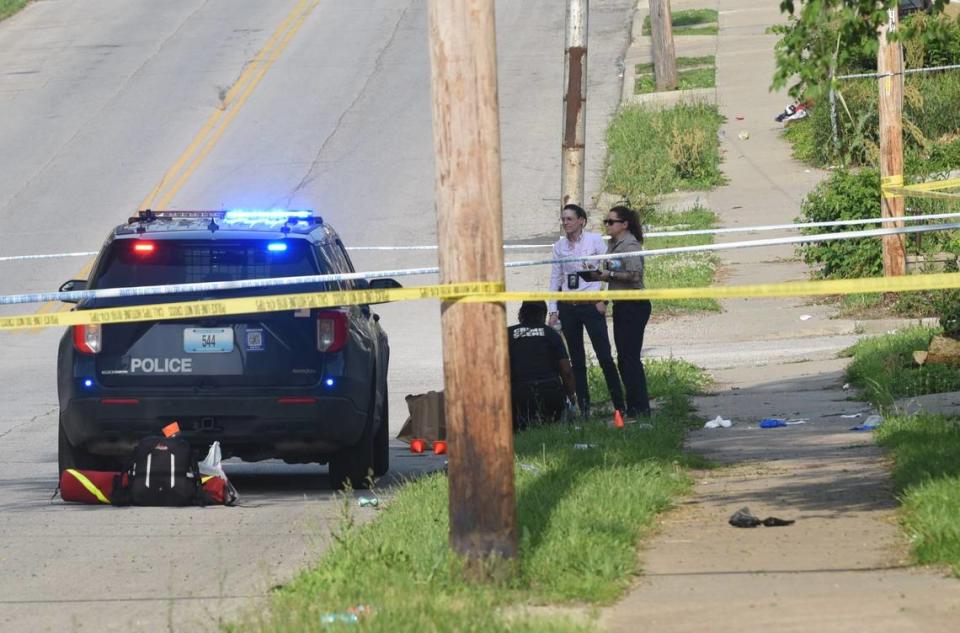
Another element of the new program involves using the city’s non-law enforcement resources to help in crime prevention.
“We (KCPD) applied a place-based analysis to determine the issues affecting Kansas City, day to day, quality of life and safety,” Graves said.
Through the city’s Public Works Department, crews will be dispatched to mow lots with overgrown weeds, repair broken sidewalks, replace street signs, demolish abandoned buildings, repair street lights and make other infrastructure improvements.
“We have places in our city that we’ve looked at over the past 10 years that have repeated violent crime,” Graves said. “If you live in some of these areas of our city, that’s generations of trauma.”
One of those areas is the seven-block radius that surrounds the neighborhoods at 35th Street and Prospect Avenue. Graves said during a recent week there were 200 gunshots fired, several non-fatal shootings, two homicides and a five-year-old child who was wounded by gunfire.
There are 23 vacant houses in the same seven-block area. Some of them are boarded up and at least one of them is on the city’s dangerous building list, she said.
Graves said violent crime often takes place in neighborhoods where residents report abandoned property, trash, and blight are most prevalent.
“At some point, our city needs to stop bringing everything from the past, and we’re talking about successes and failures,” she said. “We are where we’re at with violent crime. And this is how we are responding. It is time for everybody to get on board for us to all work together and move forward to do something to make Kansas City a safer place.”
Community trust
But for the new program to work Graves and others in law enforcement will have to repair long-existing fractured relationships between KCPD and many pockets of the urban core.
“Doing something is definitely better than doing nothing,” said Sheryl Ferguson, an organizer with It’s Time 4 Justice.
“But how can we determine that KCPD will not still act with rogue officers doing rogue actions in Black communities. So again if you’re not doing anything to obtain the trust of the community you will not get anywhere,” Ferguson said.
Amaia Cook with Decarcerate KC, a local activist group, said a safe city is only possible “when the police stop hoarding the majority of our city budget, and provide communities with what they need to stay safe and thrive.”
“We find it difficult to take KCPD seriously when they claim they’re ‘listening’ — after contributing to a legacy of racism and violence in our communities. The police consistently prioritize their own agenda, and we believe in communities coming together without the police to imagine solutions that are informed by the community,” Cook said.
That chasm played out following a listening session where Graves told the 100 attendees that she was disappointed by a couple city leaders who were too quick to say they lost the trust in KCPD.
While Graves did not name specific individuals, in an April 17 letter to the U.S. Attorney’s Office, Kansas City Councilwoman Melissa Robinson asked federal prosecutors to investigate the shooting of Ralph Yarl. The teen, who is Black, was shot and seriously injured by a white man when he went to the wrong house to pick up his siblings in a Northland neighborhood.
The shooting angered many in Kansas City and across the country who felt that race played a role in how long it took local enforcement to arrest and charge Andrew D. Lester, 84, for the shooting.
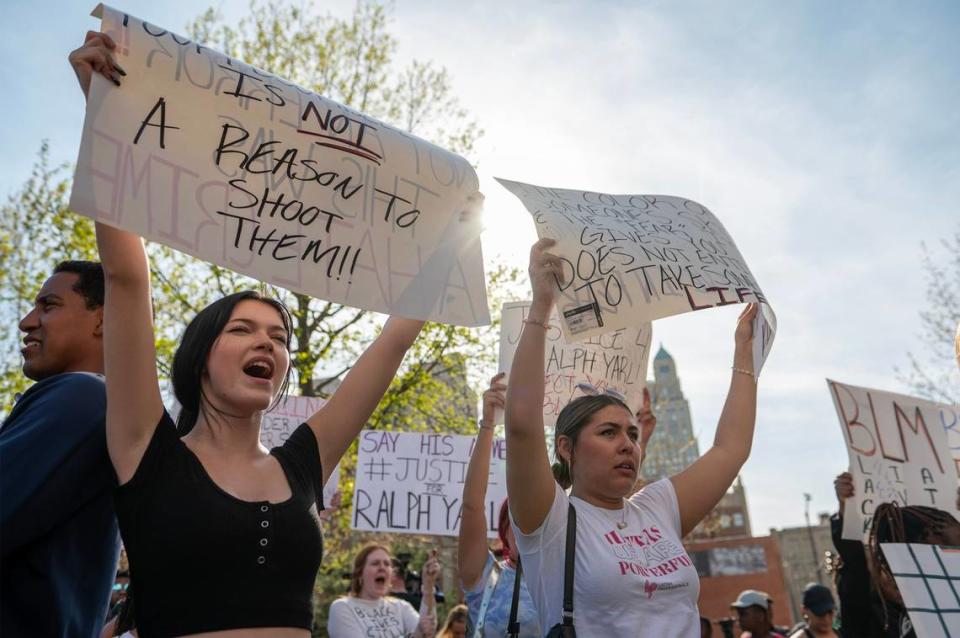
“Those words are divisive, counterproductive and ultimately hurt their constituents who experience violent crime and welcome police in their neighborhoods. I can’t say this enough – we need to work together, in all times, specifically the difficult times,” Graves said.
“This statement was not in regard to asking for a federal investigation, nor would I ever dismiss the racial component and sensitivity of the Ralph Yarl shooting. As Chief of Police, I am trying to bring people together and work to make Kansas City safer.“
Robinson told The Star she was “deeply troubled” by Graves’ comments.
“I continue to fear and will always challenge the dangers of unchecked bias in policing,” she said. “As a Black mother of two sons and as an elected official, who represents a community who disproportionately depends on the protection and service of Kansas City Police, I spoke the truth.”
“I encourage Chief Graves to focus on improving relationships with the community instead of spending valuable time degrading public officials. We have a lot of work to do,” she said.
The Star’s Kevin Hardy contributed to this report.

